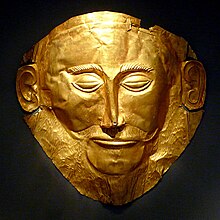From Wikipedia, the free encyclopedia
Death mask, known as theMask of Agamemnon ,Grave Circle A, Mycenae, 16th century BC, probably the most famous artifact of Mycenaean Greece.[ 1] Mycenology is the study of theMycenaean Greek language and the culture and institutions recorded in that language. It emerged as a discipline auxiliary to classical philology in 1953, following the deciphering ofMinoan Linear B script byAlice Kober ,Michael Ventris andJohn Chadwick .[ 2] [ 3]
Overview Regions
Central Greece (Aetolia-Acarnania (Aetolia ,Acarnania ),Attica ,Boeotia ,Euboea ,Evrytania ,Phocis ,Phthiotis ,Saronic Islands )Crete (Chania ,Heraklion ,Rethymno ,Lasithi )Cyclades (Andros ,Delos ,Kea ,Kythnos ,Milos ,Mykonos ,Naxos ,Paros ,Santorini ,Syros ,Tinos )Dodecanese (Agathonisi ,Astypalaia ,Chalki ,Kalymnos ,Karpathos ,Kasos ,Kos ,Leipsoi ,Leros ,Nisyros ,Patmos ,Rhodes ,Symi ,Tilos ,Kastellorizo )Epirus (Arta ,Ioannina ,Preveza ,Thesprotia )Ionian Islands (Corfu ,Ithaca ,Kefalonia ,Kythira ,Lefkada ,Paxi ,Zakynthos )Macedonia (Chalkidiki ,Drama ,Florina ,Grevena ,Imathia ,Kastoria ,Kavala ,Kilkis ,Kozani ,Pella ,Pieria ,Serres ,Thasos ,Thessaloniki )North Aegean islands (Chios ,Ikaria ,Lemnos ,Lesbos ,Samos )Peloponnese (Arcadia ,Argolis ,Corinthia ,Laconia ,Messenia ,Achaea ,Elis )Thessaly (Karditsa ,Larissa ,Magnesia ,Trikala ,Sporades )Thrace (Evros ,Rhodope ,Xanthi ) Terrain Water Environment
Society
Demographics Culture
Anastenaria Caryatid Clean Monday Concept of kingship Dress (Chiton ,Chlamys ,Exomis ,Fustanella ,Himation ,Mariner's cap ,Peplos ,Perizoma ,Tsarouchi ,Vraka )Eastern Party Festivals Folklore Greek East and Latin West Greektown Hellenization Hospitality Carols (Christmas ,New Year's ,Theophany's )
Mangas Mountza Naming customs Paideia Philhellenism andHellenophobia Plate smashing Philosophy Public holidays (Independence Day ,Ohi Day )Rouketopolemos Souliotic songs Theophany Tsiknopempti Units of measurement Worry beads Art Cuisine
Breads (Daktyla ,Kritsini ,Lagana ,Paximadi ,Tsoureki )
Desserts (Diples ,Halva ,Koulourakia ,Kourabiedes ,Loukoumades ,Melomakarona ,Pasteli ,Spoon sweets ,Vasilopita )
List of dishes Drinks (Mastika ,Metaxa ,Ouzo ,Rakomelo ,Sideritis ,Tentura ,Tsipouro ,Tsikoudia ,Frappé coffee )
Cheeses (Anthotyros ,Feta ,Graviera ,Kasseri ,Kefalotyri ,Ladotyri ,Manouri ,Metsovone ,Mizithra )Filo (Amygdalopita ,Bougatsa ,Galaktoboureko ,Karydopita ,Spanakopita ,Tiropita )Greek salad (Dakos )Meze Pasta (Gogges ,Flomaria ,Hilopites )
Restaurants (Kafenio ,Ouzeri ,Taverna )Sauces (Skordalia ,Taramosalata ,Tirokafteri ,Tzatziki )
Souvlaki Varieties (Heptanesean ,Cretan ,Epirote ,Macedonian )
Wine (Agiorgitiko ,Aidini ,Assyrtiko ,Athiri ,Kotsifali ,Lesbian ,Limnio ,Mavrodafni ,Mandilaria ,Malagousia ,Malvasia ,Moschofilero ,Retsina ,Robola ,Savatiano ,Vilana ,Xinomavro ) Languages
Greek alphabet (History ,Orthography ,Diacritics ,Braille ,Cyrillization ,Romanization (Greeklish ) andnumerals Greek language (Demotic ,Katharevousa ) anddialects (Cappadocian ,Cretan ,Cypriot ,Greco-Australian ,Maniot ,Pontic ,Tsakonian ,Yevanic )Greek Sign Language History (Mycenaean Greek ,Ancient Greek ,Koine Greek ,Medieval Greek ,Modern Greek )Literature (Ancient ,Medieval ,Modern )Minority languages (Albanian language (Arvanitika ),Aromanian ,Balkan Romani ,Bulgarian ,Ladino ,Macedonian ,Megleno-Romanian ,Turkish )Place names andexonyms Proverbs Words for love Media Music
Church music Dances (Ai Georgis ,Angaliastos ,Antikristos ,Ballos ,Dionysiakos ,Fisounis ,Gaitanaki ,Geranos ,Hasapiko ,Ikariotikos ,Kalamatianos ,Kangeli ,Kastorianos ,Kerkiraikos ,Koftos ,Pidikhtos ,Leventikos ,Maniatikos ,Metsovitikos ,Ntames ,Palamakia ,Partalos ,Pentozali ,Proskinitos ,Pyrrhichios ,Rougatsiarikos ,Sirtaki ,Sousta ,Syrtos ,Trata ,Tsakonikos ,Tsamikos ,Zeibekiko ,Zervos )Éntekhno Folk music (Cretan ,Epirote ,Heptanesian ,Macedonian ,Nisiotika ,Peloponnesian ,Pontic ,Thessalian ,Thracian )Hip Hop Ionian School Laïko (Skyladiko )Musical instruments (Askomandoura ,Aulos ,Bouzouki ,Byzantine lyra (Cretan ,Macedonian ,Politiki ,Pontic ),Crotala ,Floghera ,Gaida ,Harp ,Laouto ,Lyre ,Organo ,Pan flute ,Phorminx ,Psaltery ,Salpinx ,Santouri ,Souravli ,Tambouras ,Tambourine ,Trigono ,Tsampouna ,Tympano ,Zilia )Rebetiko Rock (Punk ) Religion and lore
Ancient religion (Origins ,Modern Revival )Aerico Buddhism Catholicism Drosoulites Eastern Orthodox Church (Timeline:Antiquity ,Early Middle Ages ,Late Middle Ages ,Early Modern Era ,19th century ,Early 20th century ,Late 20th century ,Contemporary )Fairy tales Gello Greek Orthodox Church (Ecumenical Patriarchate of Constantinople ,Church of Greece ,Flag )Greek Old Calendarists Hinduism Hypertimos Islam Judaism (History )Kallikantzaros Lamia Mormo Mount Athos Mythology (Primordial deities ,Titans ,Twelve Olympians ,Heracles ,Odysseus ,Jason ,Oedipus ,Perseus ,Daedalus ,Orpheus ,Theseus ,Bellerephon ,Satyr ,Centaur )Nymph Protestantism Psychai Sikhism Thymiaterion Name days Vrykolakas Wayside shrine Sport Symbols

